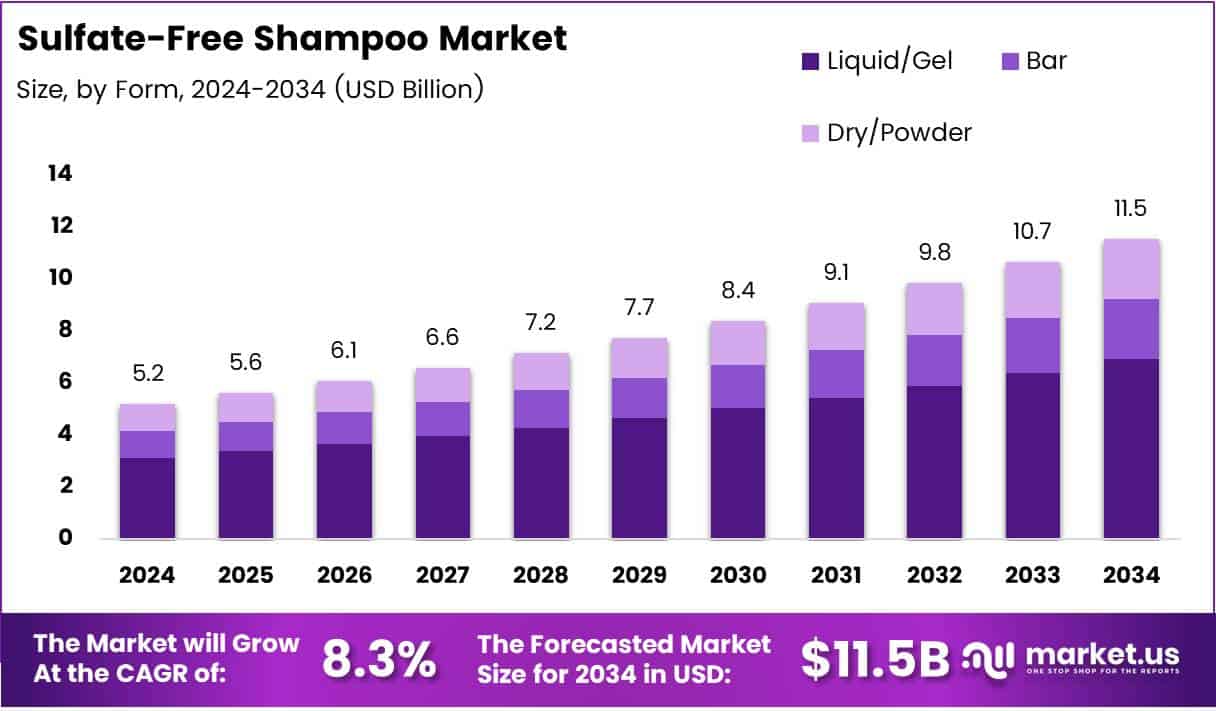Table of Contents
Market Overview
The global sulfate-free shampoo market is poised for significant growth, projected to reach a market size of USD 11.5 billion by 2034, up from USD 5.2 billion in 2024. This growth reflects a compound annual growth rate (CAGR) of 8.3% over the forecast period from 2025 to 2034.
The primary drivers of this expansion are the increasing consumer preference for gentle, natural hair care products and rising awareness about the harmful effects of sulfates on hair and scalp health.

Sulfate-free shampoos have surged in popularity as consumers increasingly seek hair care products that are gentle yet effective. Unlike traditional shampoos, which contain sulfates that strip natural oils and can cause dryness, sulfate-free shampoos provide a milder, more nourishing cleansing experience. This shift towards gentler formulations is primarily motivated by growing consumer awareness of the potential damage caused by sulfates.
Furthermore, consumer demand for clean-label, non-toxic, and eco-friendly products is accelerating the market’s growth. In particular, health-conscious consumers are prioritizing sulfate-free shampoos that are free from harsh chemicals, reflecting broader trends in the beauty and wellness industries.
Moreover, the rising prevalence of scalp-related issues such as dryness and sensitivity has prompted many to opt for sulfate-free alternatives, which are less irritating and more suitable for sensitive skin.
Market Segmentation Insights
The sulfate-free shampoo market is characterized by various segments, each catering to distinct consumer preferences:
- Form Analysis:
- Liquid/Gel: Dominating the market in 2024 with an 81.6% share, liquid and gel formulations remain the most popular due to their ease of use, convenience, and effectiveness in distributing evenly across hair strands.
- Bar: Gaining traction for their eco-friendly appeal, bar shampoos are favored by environmentally conscious consumers looking for sustainable, zero-waste options.
- Dry/Powder: While still a niche segment, dry or powder-based shampoos are expected to grow as on-the-go convenience becomes a more prominent consumer need.
- End-Use Segmentation:
- Women: Women represent the largest consumer group, holding a 51.6% market share in 2024, driven by demand for gentle hair care products that prevent scalp irritation and damage.
- Men: While a smaller segment, the male consumer base for sulfate-free shampoos is expanding, influenced by growing awareness about scalp health and grooming.
- Unisex: This segment is emerging as a versatile product option, appealing to consumers seeking multifunctional hair care solutions.
- Distribution Channel Analysis:
- Specialty Stores: Leading the market with a 37.9% share in 2024, specialty stores provide a personalized shopping experience and focus on natural and organic beauty products, making them the preferred choice for consumers looking for sulfate-free shampoos.
- Supermarkets & Hypermarkets: Offering convenient access to sulfate-free products, this distribution channel caters to mass-market consumers.
- Online Retail: E-commerce is rapidly growing as a preferred shopping method, with consumers appreciating the convenience of online shopping and the ability to access a wide variety of sulfate-free products.
Regional Market Insights
- Europe: Dominating the market with a 35.1% share valued at USD 1.8 billion in 2024, Europe is the leading region in the sulfate-free shampoo market. The region benefits from strong consumer awareness regarding the dangers of sulfates and a high demand for natural and organic personal care products.
- North America: Following Europe, North America has a mature market driven by ingredient transparency and a preference for sustainable beauty products. The rise in sensitive skin conditions is further fueling the demand for sulfate-free shampoos in the region.
- Asia Pacific: Rapidly expanding due to rising disposable incomes and increasing beauty consciousness, Asia Pacific is becoming a key market for sulfate-free shampoos. Countries such as China, India, and South Korea are seeing increased adoption of premium hair care solutions.
- Latin America and Middle East & Africa: While these regions show moderate growth, awareness is increasing, especially in urban areas where consumers are increasingly inclined toward premium, health-conscious beauty products.
Challenges and Opportunities
Despite the growth prospects, the sulfate-free shampoo market faces several challenges, including limited awareness in rural and developing regions, where consumers may be unfamiliar with sulfate-free products. Additionally, the higher price point of sulfate-free shampoos compared to conventional alternatives can be a barrier to wider adoption.
However, opportunities abound for brands that focus on specific consumer needs. The development of sulfate-free shampoos tailored for ethnic and textured hair types presents a significant growth opportunity. Furthermore, eco-friendly packaging and expanding into men’s grooming and baby care segments can help brands reach new consumer bases.
Key Market Players
- Johnson & Johnson
- Davines
- Unilever
- Moroccanoil
- L’Oréal
- Ethique Consumer End Uses, Inc
- Henkel Corporation (Zotos Professional)
- The Estée Lauder Companies (Aveda)
- Procter & Gamble
- Hush Health Limited
These companies are driving innovation in product formulation, packaging, and marketing strategies, creating a competitive landscape that continues to evolve with consumer preferences.
Recent Developments
- In January 2024, Hair and Scalp Line Jupiter successfully secured a $3 million funding round to expand its innovative hair care solutions and strengthen its presence in the market.
- In July 2024, D2C haircare brand Moxie Beauty raised ₹17.3 crore, led by Fireside Ventures, to fuel its product development and accelerate its growth in the competitive beauty industry.
- In September 2024, haircare brand Seen raised $9 million in a Series A funding round to expand its clean beauty products and enhance its market penetration.
Conclusion
The sulfate-free shampoo market is undergoing a transformation as consumers seek safer, gentler alternatives to traditional hair care products. With increasing demand for clean, natural beauty solutions and the rise of eco-conscious consumerism, the market is set for sustained growth. Brands that focus on product innovation, sustainable practices, and expanding into new consumer segments will be well-positioned to capitalize on the opportunities within this rapidly evolving industry.
Discuss Your Needs With Our Analyst
Please share your requirements with more details so our analyst can check if they can solve your problem(s)





